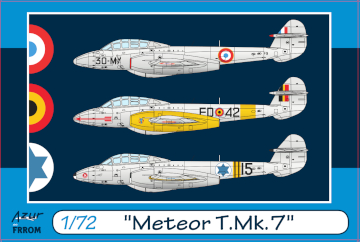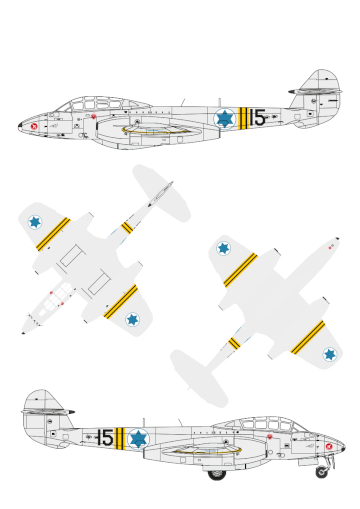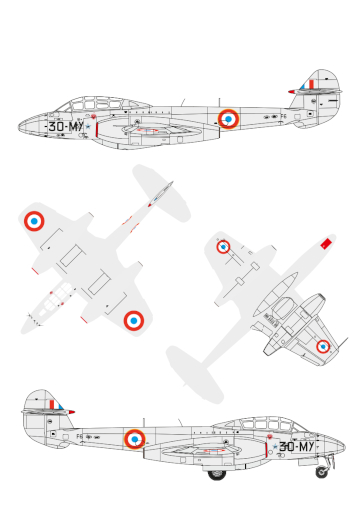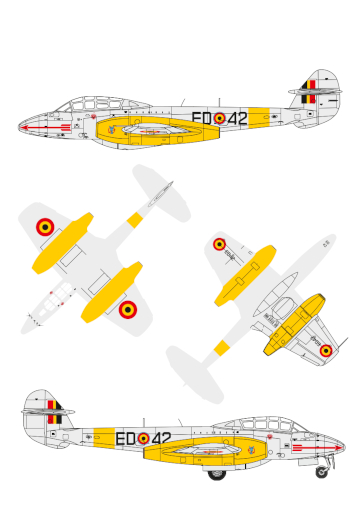FR0045 Meteor T.Mk.7
History:
One of the first jet fighters, the Gloster Meteor became operational in July 1944 with both the F.Mk.I & III variants seeing service by WW2’s end in 1945. The Meteor T.Mk.7 was developed post-war as a 2-seat training version. Over 600 trainers were produced with the UK, unsurprisingly, being the largest user, although several other nations would also operate smaller quantities of T.Mk.7s as indicated here - Australia 7, Belgium 42, Brazil 10, Denmark 9, Egypt 6, France 14+, Israel 6, Netherlands 45, New Zealand 2, and Sweden 3.

Egypt first obtained Meteors in 1949-50, thus giving its air force a significant technological advantage over that of Israel. The UK then sold Israel Meteors in 1954-55 which restored some balance in the air-fighting capability of these Middle East adversaries.
Israel Ben Shachar became the first Israeli jet-pilot when he flew a Meteor T.MK.7 in the UK prior to Israel’s initial Meteor procurement of two T.Mk.7s and 11 F.Mk.8s. The first jets to land in Israel were two Meteor T.MK.7s on the 17th of June 1953. To mark the significance of this occasion the aircraft were named Sofa and Sa'Ar by the Israeli Prime Minster, David Ben Gurion. They were to be operated by the Israeli Air Force’s (IAF) 117 Sqn, which was also equipped with the Meteor F.Mk.8. The IAF’s six T.MK.7s were coded Aleph 13 to 18.
The IAF added a belly camera to these planes and used them for photo-reconnaissance. Black 13 was lost in the lead-up to the 1956 Suez Crisis, referred to as Operation Kadesh by Israelis and Operation Mousquetaire/Musketeer by the French and British forces respectively. During these operations Israeli, French, and British aircraft had vivid Identification markings of black & yellow ‘Suez Stripes’ applied in a similar manner to WW2 black & white ‘D-Day Stripes’. The IAF Meteor T.Mk.7s flew photo-recon missions and provided higher HQ planners with a good view of the actual battleground situation.
Following the Suez Crisis, the Meteor T.Mk.7s resumed peacetime operations. One was lost on September 26th, 1960 to a bird-strike with the crew bailing out safely. Two more . MK.7s were lost in April 1962 and November 1966.
Israel’s Meteor T.MK.7s were finished in natural metal with six Star of David national insignia in the usual positions. Each aircraft’s number was initially preceded by the Hebrew letter ‘aleph’ and applied in black to the fuselage sides and nosewheel door. The nose cone, engine intake lips, and the tailplane’s bullet-shaped fairing were quartered in black and white, matching the squadron’s Meteor F.Mk.8s which wore the same livery.
France received at least fourteen Meteor T.Mk.7s, eleven of which were ex-RAF machines that were coded F1 to F11. There may have been two additional machines from an embargoed Syrian order. Meteor T.MK.7s served with the 30 ème Escadre de Chasse (in Tours), the Centre d'Instruction Tout Temps (CITT 346, Reims, an all-weather Training Centre), le Centre d'Essais en Vol (C.E.V., Test Flying Centre), and EPNER (Istres). The C.E.V. is usually thought to have received seven of these aircraft. Three were known by their ex-RAF serial numbers of 997 and 228, previously the RAF’s WG-997 and WH-228 respectively. They were delivered in March and September 1952, whilst number 776 was taken on charge in 1956. Four of the eleven ex-RAF aircraft were distributed as follows - F1 and F2 going directly to the C.E.V. in 1952, whilst F6 and F9 were initially assigned to the 30 ème Escadre, then to CITT 346, and finally to C.E.V. in January 1956.
By November 1967 only F6 and F9 remained with EPNER, the other T.Mk.7s having been scrapped. F9 was used for training in the 2/30 « Camargue », in Tours, and was coded 30-MY in 1953. F6 and F7 were coded 346-QW and 346-QX, respectively.
Belgium purchased three T.MK.7s built by Gloster (ED1 to 3) plus nine more diverted from an RAF order (ED4 to ED12). Having already acquired 48 Meteor F MK.4s, Belgium converted twenty into T MK.7s (ED13 to ED32). Later, the penultimate batch of five T.Mk.7s (ED33 to ED36), followed by the final batch of six (ED37 à ED42), were bought, both batches again being diverted from RAF orders.
The Belgian T.MK.7s mainly flew with the Coxyde Fighter School. Belgium also operated some Meteor F.Mk.8s and produced some T.Mk.7.5 ‘hybrids’ which had an F.Mk.8 Tail fitted to a T.Mk.7 fuselage. Four of these T.Mk.7.5 ‘hybrids’ were later sold to Israel in December, 1957.
Specifications: Training version of the Meteor with a crew of two. Engines: 2 x Rolls-Royce Derwent delivering a 15.6 KN thrust. Wingspan 11.3 m, length 13.3 m. Ceiling 13,716 m. Weight: 6,455 kg.
- Jean-Jacques Petit, Yoav Efrati, IPMS Belgium, Jean Goderniaux
Camouflages :
- Cam A : T Mk.7 coded Black 15 of the Israeli Air Force, in January 1957, shortly after the Suez crisis, with yellow and black stripes, Sqn 117 badge on nose, all aluminium, with air intakes and nose quartered black and white. Roundels at six usual positions. Israel.
- Cam B : T Mk.7 coded 30-MY, Tours, escadrille 2/30 "Camargue", summer 1956. All aluminium. Armée de l'Air.
- Cam C : T Mk.7 EDo42 with yellow engines and yellow fuselage band. Fighter School, Coxyde, Belgium, 1958


